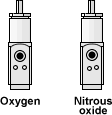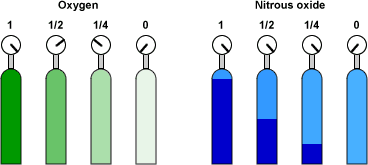|
Compressed
Gas Supply
Gases used in
anesthesia are usually supplied under high pressure in spun steel
or aluminum cylinders of varying capacity. The most commonly used
sizes are:
- H - free-standing,
attached to the anesthesia machine by a flexible hose. These are
most economical, but reduce the mobility of the anesthesia machine.
The hose to
the anesthetic machine should be at a regulated pressure of 50
psi (i.e the regulator should be attached to the cylinder and
not to the anesthetic machine). This is very much safer
than having the hose running from the cylinder to the machine
at cylinder pressure (up to 2000 psi).
- E - attached
directly to the anesthesia machine via a yoke. These allow the
anesthesia machine to be more mobile, but are more expensive to
operate.
| Size |
Capacity
(liters) |
|
Oxygen |
Nitrous
oxide |
| E |
660 |
1590 |
| H |
6900 |
15800 |
The best solution
is often to have an H cylinder connected to the machine when it
is in the operating room, but to have E cylinders attached which
can be used when the machine has to be moved.
Gases found
on anesthesia machines
Gases commonly
used in veterinary anesthesia include:
- Oxygen
- essential for respiration.
- Nitrous
oxide - not sufficiently potent to produce anesthesia alone
in veterinary patients, but used to provide analgesia and reduce
the requirement of other more potent agents.
Other gases
that may be encountered (mainly on medical machines) include:
- Carbon
dioxide
- used
to stimulate breathing after intermittent positive pressure ventilation.
- Helium
- used in laser surgery aound the airway to reduce the flammibility
of the breathing mixture.
- Cyclopropane
- an obsolete (explosive) anesthetic found on some older medical
anesthesia machines.
- Medical
Air - commonly found on modern medical machines to dilute
oxygen when other gases are not desired.
Other gas
sources
A central supply of liquid oxygen may also be provided in large
hospitals. Other sources of oxygen include oxygen generators (which
chemically generate oxygen from, for example, hydrogen peroxide)
and oxygen extractors (which extract oxygen from atmospheric air).
Although these are not widely used in developed countries, they
may be useful in areas where supplies of compressed gas are hard
to obtain.
Identification
Correct
identification of the gas being supplied to the anesthesia machine
is clearly vital if potentially lethal accidents are to be avoided.
A number of different measures are taken to ensure this:
- Color-coding
of cylinders provides a rapid means of identifying their contents.
The definitive indicator of the contents is, however, always
the label.
- A gas-specific
pin-index system is provided on small cylinders: pins on the yoke
of the anesthetic machine mate with holes drilled in specific
positions on the valve of the cylinder to provide a mechanical
means of preventing incorrect connection.
 
- Gas-specific
connectors are used on large (G and H) cylinders that make it
impossible to attach a regulator or fitting to the wrong cylinder:

Cylinder
contents
A pressure gauge indicates the pressure within each cylinder. In
the case of oxygen (below), and other gases which do not liquify
at normal temperatures, this enables estimation of the contents
since the amount of gas contained in the cylinder is proportional
to the pressure.

This is not
so for vapors, such as nitrous oxide, which are liquified by the
high pressure within the cylinder (above). Here, the pressure remains
relatively constant until all the liquid is evaporated, after which
the pressure drops rapidly as the remaining gas is removed. The
contents of these cylinders can only be estimated by weighing the
cylinder.
Hazards
The use of cylinders containing gas at high pressures presents a
number of hazards:
- Falling
of unsecured cylinders may lead to:
- Direct
injury of personnel.
- Explosive
decompression if the valve breaks off, which will turn the
cylinder into a lethal projectile.
- These
hazards mandate that all cylinders be secured to a wall or placed
on special carts.
- Fires
and explosions may be caused by the oxidizing ability of oxygen
and nitrous oxide: no grease must used in the threads of the valves
or connectors.
- Incorrect
identification of the contents of cylinders is a potential
hazard.
Regulators 
|




